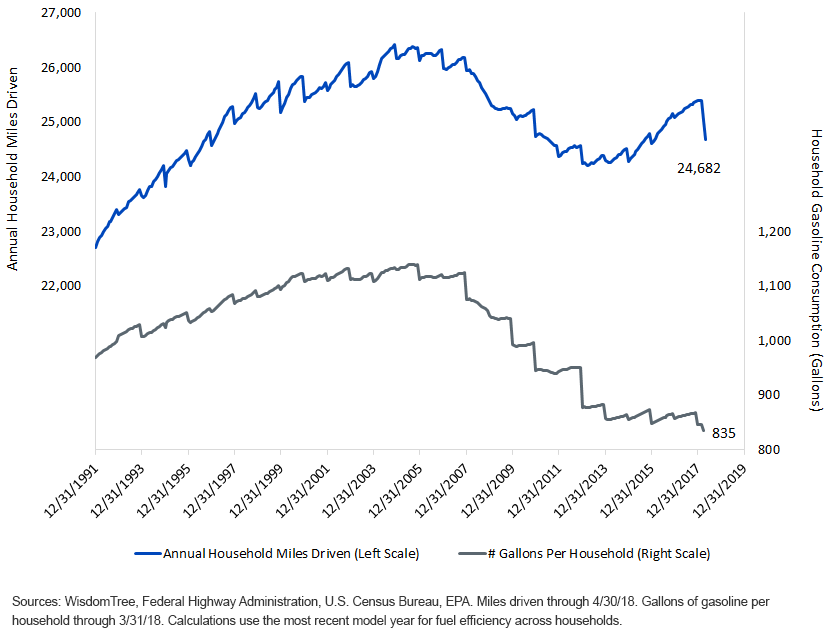By Jeff Weniger, CFA, WisdomTree Investments
Special to the Financial Independence Hub
“Judging by the oil market in the pre-OPEC era, a ‘normal’ market price might now be in the $5-10 range … Last week Algeria’s energy minister declared, with only slight exaggeration, that prices might conceivably tumble ‘to $2 or $3 a barrel.’”
—The Economist, March 4, 1999
That quote feels like it was from a million years ago. A decade later, straight-faced economists would be talking about US$200 or US$300 per barrel. Times change.
With oil two years along in a bull rally that has witnessed its price triple from lows in the first quarter of 2016, it may be just a matter of time before the purported list of stock market obstacles starts to include retail gasoline pain. With West Texas Intermediate (WTI) crude oil changing hands at US$67.44 and Brent crude at US$73.26, it’s hard not to be scared off by our collective ups and downs at the gas station.1
After regular unleaded challenged US$4 a gallon — $3.695, to be precise2 — in the summer of 2014, many strategists began to fear the worst. Gasoline would once again deal the death blow to the American middle and lower classes, as it had a half-decade prior.
But 2014 marked the worst of it, at least for now. WTI crude oil collapsed from triple digits to less than $30 in early 2016. Retail gas followed along, to levels south of $1.80.
But it has quietly chipped back, closing the first quarter at $2.57, and $3 looms in the American psyche. Unlike in Canada, where expensive fossil fuel prices tend to benefit the federal budget, Alberta employment and so forth, Americans historically have had no similar solace outside of petroleum-rich Texas and Alaska, perhaps. It’s just a different economy. People remember the first time they saw a gas station post a price of $1, then $2, then $3. And at $4, that memory strikes the gut: the insolvency years.
Regular Canadians feel pain from expensive gasoline, for sure, but not quite like the pain that hits Americans.
Tie the threat of a national average of $3 per gallon south of the border, maybe during the Labor Day road trip, with the possibility that U.S. Fed Chairman Jay Powell may bring two or three more rate hikes of 25 basis points by this year’s close, and it is not much of a leap to be sympathetic to a thesis of a gasoline-induced blow to American consumer confidence. But be careful, because that thesis is flawed.
Whispers
The “whisper number” on Saudi aspirations for Brent crude is $80 to $100 per barrel. But Donald Trump was already tweeting angrily at $70 per barrel, so it is reasonable to assume that another $20 to $30 would unwind much progress on recently fruitful U.S.-Saudi relations. But suppose ROPEC — Russia plus OPEC — marks oil up to $100 anyway. Gasoline could be closer to $4 than $3 in that circumstance. Does that break the American consumer? A half-generation or a generation ago, yes — certainly. But psychological anchoring on round numbers like $100 or $3.00 deceives. Consider our analysis below.
Our 2018 Reality
Figure 1 places unleaded gasoline costs in context. The U.S. population of some 322 million people consists of 126 million households driving more than 3 trillion miles per year. But because millennials do not drive as much as their predecessors, the number of auto miles driven per household has fallen to less than 25,000 from a peak of 26,413 in 2004.
Additionally, today’s cars are essentially computers on wheels, and fuel efficiency is notably higher than it was in prior years.
Twenty years ago, the American new car fleet got 23.4 miles to the gallon.3 By 2008, it was virtually unchanged, at 24.3. But the U.S. got burned on triple-digit oil, making it somewhat politically palpable when the Obama administration pushed forward with mandated 54.5 mpg fuel economy targets for model year 2025. In pursuit of such efficiency, the new car fleet’s efficiency rose to 30.0 mpg for the 2017 crop.
For the math in figure 1, we make the leap that all households own the latest model-year automobile, which of course they do not. Using that concept for illustration, households of yesteryear were using 1,100 gallons of gasoline per year. The figure has been in fortunate freefall because of reduced auto usage and fuel efficiency, and now stands at just 835 gallons per household.4
Figure 1: U.S. Household Auto Usage
Frankly, $2.57 gasoline doesn’t have the same bite on Americans as it once did. Using wages reported to the Social Security Administration and our calculation of the number of income earners in each household, we find that the typical home in that country is currently reporting to the tax authorities $57,122 from all earners. That is up from $44,952 at the beginning of this decade, because millions of laid-off workers now have earned income again and because wages have risen, albeit at a crawling pace.
Figure 2 shows the stark contrast between what gasoline meant to Americans at the apex of the “commodities supercycle” relative to today. In mid-2008, when the average U.S. household had $48,213 in Social Security earnings, if people were driving a late-model car that got 24.1 mpg, they were gobbling 1,067 gallons of gasoline at $4.09 a gallon. That was 9.1% of every dollar that flowed into the household.
Today, there’s a sharp contrast. If the same household is driving today’s late-model vehicle, which gets 30 mpg, not only are people driving less, but the vehicle doesn’t have to fill up as frequently. Their gas consumption has fallen 19.7% in one decade, they earn about $9,000 more, and the price itself is still south of $3. Current gasoline expenditure is just 3.8% of the earnings regular households are reporting to Uncle Sam, an amount akin to the cheap gasoline era of the booming 1990s.
Figure 2: Gasoline as % Household Income, U.S.
By any standard of modern history, the gasoline price would have to spike another dollar, maybe even two — and do so rapidly because of the fuel economy arms race — before Middle America feels a pinch anything like the old days. Whether $70 per barrel is high or low is another issue. If the question is whether regular people in the U.S. are being crushed, thereby threatening the global order, or whether $100 oil will do the trick, the answer appears to be “no.”
1All money expressed in U.S. dollars
2Source: Bloomberg, 5/1/18.
3All gasoline price references sourced from the U.S. Energy Information Administration, April 2018 Monthly Energy Review.
4Source: U.S. Environmental Protection Agency, using the 55/45 city/highway driving standard.
5Calculations by WisdomTree using federal government data through 3/31/18.
 Jeff Weniger, CFA serves as Asset Allocation Strategist at WisdomTree. Jeff has a background in fundamental, economic and behavioral analysis for strategic and tactical asset allocation. Prior to joining WisdomTree, he was Director, Senior Strategist with BMO from 2006 to 2017, serving on the Asset Allocation Committee and co-managing the firm’s ETF model portfolios. Jeff has a B.S. in Finance from the University of Florida and an MBA from Notre Dame. He is a CFA charter holder and an active member of the CFA Society of Chicago and the CFA Institute since 2006. He has appeared in various financial publications such as Barron’s and the Wall Street Journal and makes regular appearances on Canada’s Business News Network (BNN) and Wharton Business Radio.
Jeff Weniger, CFA serves as Asset Allocation Strategist at WisdomTree. Jeff has a background in fundamental, economic and behavioral analysis for strategic and tactical asset allocation. Prior to joining WisdomTree, he was Director, Senior Strategist with BMO from 2006 to 2017, serving on the Asset Allocation Committee and co-managing the firm’s ETF model portfolios. Jeff has a B.S. in Finance from the University of Florida and an MBA from Notre Dame. He is a CFA charter holder and an active member of the CFA Society of Chicago and the CFA Institute since 2006. He has appeared in various financial publications such as Barron’s and the Wall Street Journal and makes regular appearances on Canada’s Business News Network (BNN) and Wharton Business Radio.
Commissions, management fees and expenses all may be associated with investing in WisdomTree ETFs. Please read the relevant prospectus before investing. WisdomTree ETFs are not guaranteed, their values change frequently and past performance may not be repeated. Past performance is not indicative of future results. This material contains the opinions of the author, which are subject to change, and should not to be considered or interpreted as a recommendation to participate in any particular trading strategy, or deemed to be an offer or sale of any investment product and it should not be relied on as such. There is no guarantee that any strategies discussed will work under all market conditions. This material represents an assessment of the market environment at a specific time and is not intended to be a forecast of future events or a guarantee of future results. This material should not be relied upon as research or investment advice regarding any security in particular. The user of this information assumes the entire risk of any use made of the information provided herein. Neither WisdomTree nor its affiliates provide tax or legal advice. Investors seeking tax or legal advice should consult their tax or legal advisor. Unless expressly stated otherwise the opinions, interpretations or findings expressed herein do not necessarily represent the views of WisdomTree or any of its affiliates. “WisdomTree” is a marketing name used by WisdomTree Investments, Inc. and its affiliates globally. WisdomTree Asset Management Canada, Inc., a wholly-owned subsidiary of WisdomTree Investments, Inc., is the manager and trustee of the WisdomTree ETFs listed for trading on the Toronto Stock Exchange.





Great article. I remover filling the motor home with 1.67 in Ohio not long ago. Good to see a price analysis on a practical element of living.